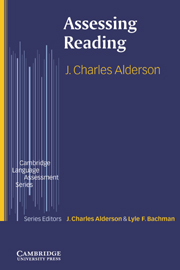Book contents
- Frontmatter
- Contents
- Series Editor's Preface
- Acknowledgements
- Abbreviations
- 1 The nature of reading
- 2 Variables that affect the nature of reading
- 3 Research into the assessment of reading
- 4 The reader: defining the construct of reading ability
- 5 A framework for test design
- 6 Tests in the real world: test purposes
- 7 Techniques for testing reading
- 8 The development of reading ability
- 9 The way forward. Assessing the interation between reader and text: processes and strategies
- Bibliography
- Index
9 - The way forward. Assessing the interation between reader and text: processes and strategies
Published online by Cambridge University Press: 03 May 2010
- Frontmatter
- Contents
- Series Editor's Preface
- Acknowledgements
- Abbreviations
- 1 The nature of reading
- 2 Variables that affect the nature of reading
- 3 Research into the assessment of reading
- 4 The reader: defining the construct of reading ability
- 5 A framework for test design
- 6 Tests in the real world: test purposes
- 7 Techniques for testing reading
- 8 The development of reading ability
- 9 The way forward. Assessing the interation between reader and text: processes and strategies
- Bibliography
- Index
Summary
Assessing the interaction between reader and text: processes and strategies
This chapter will be more speculative in nature, and will explore how aspects of the reading process that have been recently considered to be important can be assessed. Language testing has traditionally been much more concerned with establishing the products of comprehension than with examining the processes. Even those approaches that have attempted to measure reading skills have in effect inferred a ‘skill’ from the relationship between a question or a task, and the text. Thus the ‘skill’ of understanding the main idea of a passage is inferred from a correct answer to a question which requires test–takers to identify the main idea of that passage. There is little experience, especially in large–scale testing, of assessing aspects of processes and strategies during those processes. I shall therefore have recourse to non–testing sources for ideas on how process might be assessed. In particular, I will look at how reading strategies have been taught or learned, how researchers have identified aspects of process through qualitative research techniques, and how scholars have explored the use of met a linguistic and met a cognitive abilities and strategies.
In suggesting that we should look further a field than traditional testing and assessment practices in order to develop ways of assessing processes and strategies, this chapter inevitably leads into a discussion of directions in which assessment might develop in future, including the use of information technology.
- Type
- Chapter
- Information
- Assessing Reading , pp. 303 - 357Publisher: Cambridge University PressPrint publication year: 2000



